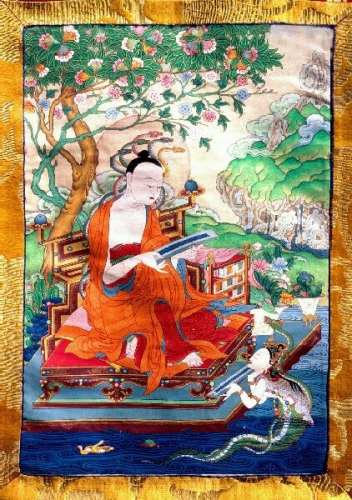The object of knowledge in dream is not seen when one
awakes. Similarly the world disappears to him who is
awakened from the darkness of ignorance.
The creation of illusion is nothing but illusion. When
everything is compound there is nothing which can be
regarded as a real thing. Such is the nature of all things.
-Mahayanavimsaka of Nagarjuna

Nagarjuna, Arya (Tibetan: pag pa lhu drup): founder of the philosophical system known as Madhyamaka, the Middle Way School. His exact dates are not known but it is generally believed he lived around the time of the 1st and 2nd centuries C.E. The Problem of the Historical Nagarjuna Revisited by Ian Mabbett. The Journal of the American Oriental Society, Vol.118 No.3 (July 1998).
Nagarjuna
It was prophesied at his birth that Nagarjuna would live for only ten days but because of pious actions by his father, his life expectancy was raised to seven years. At age seven his parents sent him away from their home because they could not bear the thought of seeing his corpse. He eventually arrived at the great monastic academy Nalanda. At Nalanda he was initiated into meditation practice by the master Saraha (Rahulabhadra) and attained immortality. Nagarjuna became a great teacher and was widely known in all Buddhist traditions.
Over time Nagarjuna’s grasp of the Buddha’s teaching deepened and he expressed his understanding in a series of commentaries which taught the doctrine of emptiness and clarified the Middle Way. His teachings became especially revered and important to practitioners of the Mahayana Buddhist Tradition and became the foundation for the Madhyamaka School of philosophy. At one point during Nagarjuna’s long life of ceaseless teaching, Nagas, nature spirits that appear as snakes, visited him. The Nagas offered him a teaching of Shakyamuni Buddha known as the One Hundred Thousand Verse Prajnaparamita Sutra that had never been seen in the human world. Nagarjuna also established a vast number of temples and stupas and converted countless non-Buddhists in great debates. The end of Nagarjuna’s life was spent in mediation at Shri Parvata and after his death Aryadeva carried on his work.
Monty McKeever 2-2006
Originally published on HAR (with 11 paintings)
Further reading:
“Nagarjuna’s Verses from the Center” by Stephen Batchelor
“The Dharma of Deconstruction” by David Loy